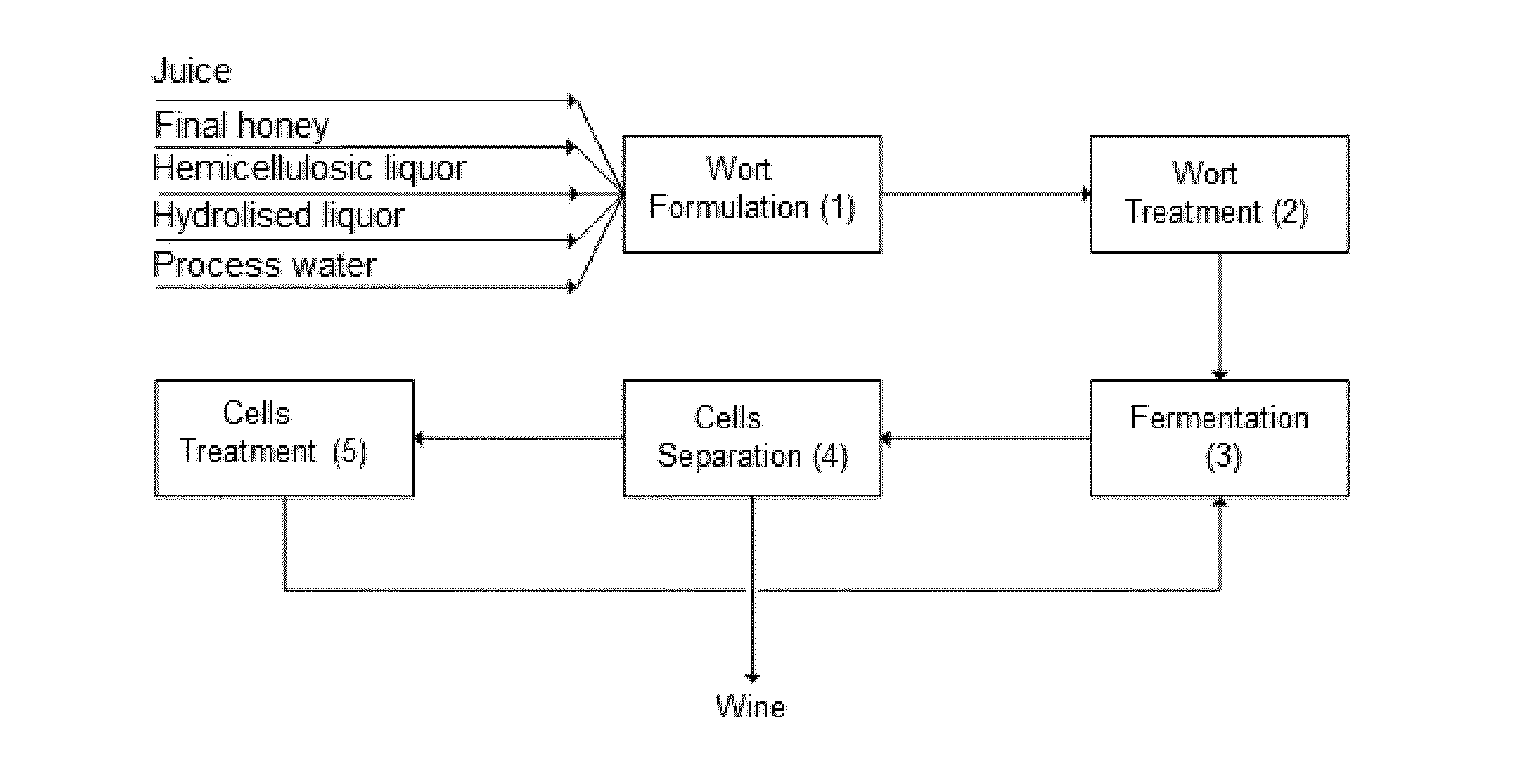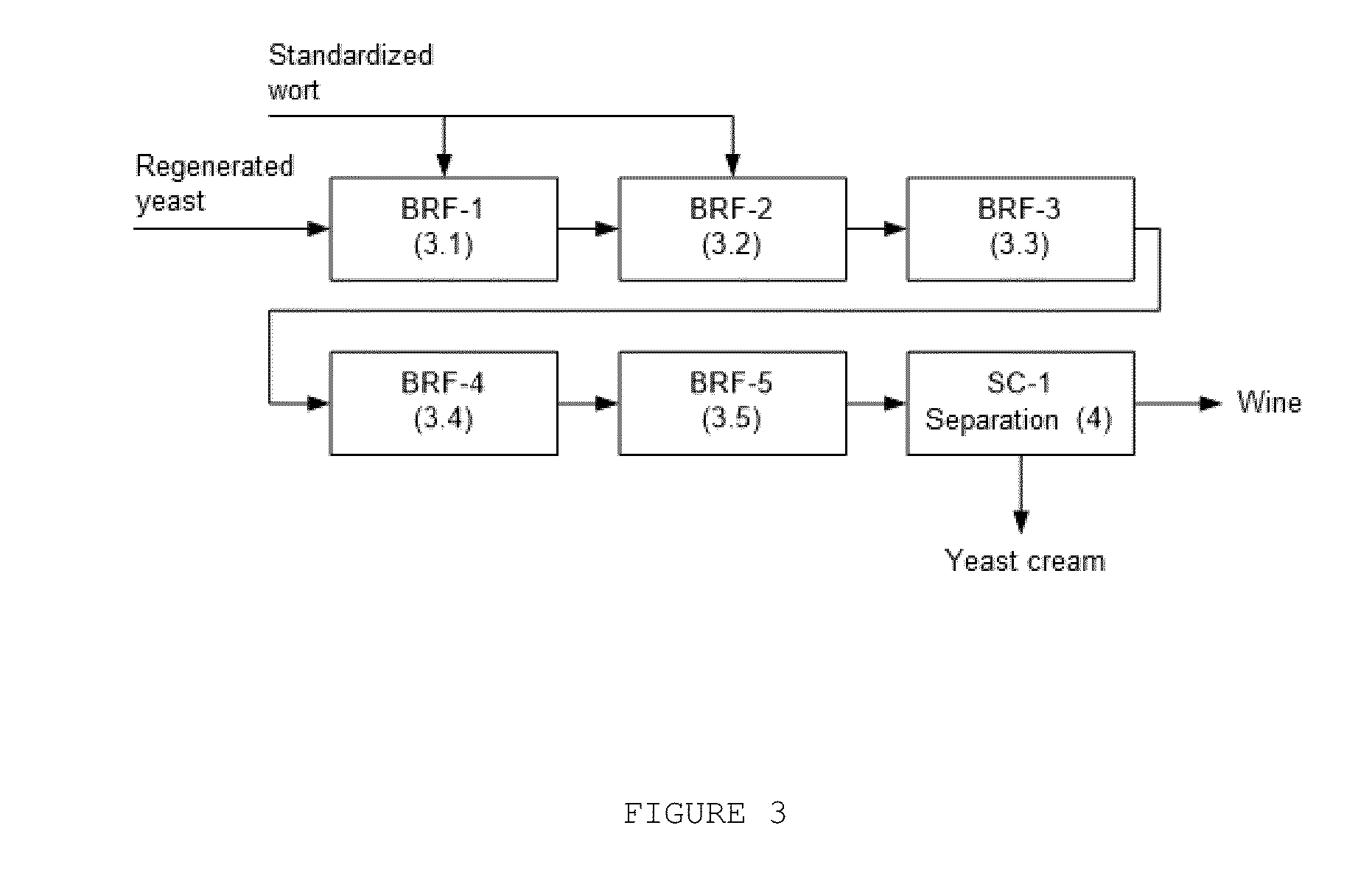This will result in the process to deal with
raw material of good (juice) or low (molasses) quality and also cause variation in the production capacity.
Thus, a
continuous fermentation unit would not be able to absorb these fluctuations and would compromise the productivity and the revenue.
Andrietta (2003) also reported the evolution of
continuous fermentation wherein the first units were assembled from adjustments of the existing infrastructure, which resulted in an inadequacy of the reactors design, incompatibility in the form of
supply and distribution of wort.
The presence of contaminants in the fermentation process causes the yeast
flocculation, reduces the efficiency of centrifuges and the yeast
recovery reducing the fermentation yield.
Furthermore, some contaminating
bacteria are capable of consuming the generated
ethanol and the like, causing the death of yeast through the production of toxins excreted in the medium.
Currently, the practice of installations for the contaminants control is the application of chemicals and
antibiotics and this is condemned in Europe and some Asian countries, since the intensive use of
antibiotics leads to the development of naturally resistance by contaminants.
The bacterial
contamination is mostly brought by the wort, since it is a medium containing
sugar made from
sugar cane juice and molasses, and in which there is no practical sterilization for
elimination or reduction of contaminating microorganisms.
The
alcohol causes changes in the lipid layer composition of the
microorganism membrane, deleterious
protein synthesis for the modulation of
ion exchange processes, and reduction in glucose transport decreasing the
product formation and causing
water stress (Hallsworth, 1998 Martini et al., 2004).
It is not very recommended to recycle this
wash water, because it may be a source of
contamination and, in the
distillation case, will occur the increase of steam consumption.
Thus, in case of continuous fermentation, the toriconical bottom would not be justified and would present a
disadvantage to promote a homogeneous mixture in some steps of the fermentation.
Still with respect to the information provided by COPERSUCAR (1987), it is known that the foam creates many problems during fermentation.
Foams with great stability and elasticity, for example those formed during the juice reaction for the
alcohol production, cause the
volume loss useful in the vat, filling speed limitation, loss of
wine, yeast and wort through overflow.
The antifoam used to decrease the amount of foam generates waste, which cause blockages in the
system equipment, and also new surfactants which are less aggressive to the centrifugal and metallic surfaces, are expensive, being their use restricted.
However, there are disadvantages in the installation in a demand of a greatest area and in the process, with the increased of surface area, which means a greater
exposure to air, when there is a low production of
carbon dioxide, especially at the beginning and end of fermentation, which results in a deviation in the
metabolism of yeasts for microbial
reproduction on the basis of
aeration.
One of the main challenges of the VHG technology applied to fermentation for ethanol production is to maintain the activity and viability of microorganisms over an entire season.
This process is not widely used in sugar mills due to operational difficulties in view of the high
osmotic pressure of the salts accumulation and low fermentation yield mainly associated with the production of
glycerol and cells.
Again, the most serious problem of this process is that the yeast cream does not undergo refreshment, instead is sent directly to the fermenter having its lifetime reduced and no further reports the
temperature control range of the fermentation and the
alcohol content range of
wine.
Furthermore, the yeast cream after exhaustive use is eventually turned off, due to the presence of natural inhibitors from the fermentation process.
In this case, flocculent yeasts are used because there is no need for a
centrifuge, however, the microorganisms are not recovered and reactivated, which decreases its lifetime.
In this process, the already used yeast does not undergo through refreshment process again, so there is accumulation of inhibitors and contaminants.
According to COPERSUCAR (1987), the processes with new yeast addition may lead to external contamination during the initial spread phases for each new cultures loading to the reactor, because they facilitate competition with other microorganisms other than that of interest for the industry.
The removal of cellular
biomass of the second step is carried out by overflowing, which prevents its industrial application, since the volumes used in the mills renders unfeasible this type of transfer.
Despite presenting a more efficient cooling
system, the document does not bring a reactivation yeast
system, applying only acid for the detoxification of the medium, which is not sufficient to maintain the fermentation agent active by satisfactorily long time working in
high alcohol content.
The process, however, does not study new equipments to improve the conventional fermentation process.
In both cases, the yeast used is not widely applied in industry.
The main purpose of the new design is the control of foam formation, however, does not claim the use of anaerobic fermentation processes such as alcoholic fermentation.
A prior art drawback is that there is no feed on two or more bioreactors to improve the conversion of sugars to ethanol, distribution of
thermal load, and stirring the
carbon dioxide release.
A prior art drawback is that there are not two steps of
cell separation in different units aimed to remove inhibitors, reduce the buffer effect, and improve the
acid treatment and cellular reactivation.
 Login to View More
Login to View More 


